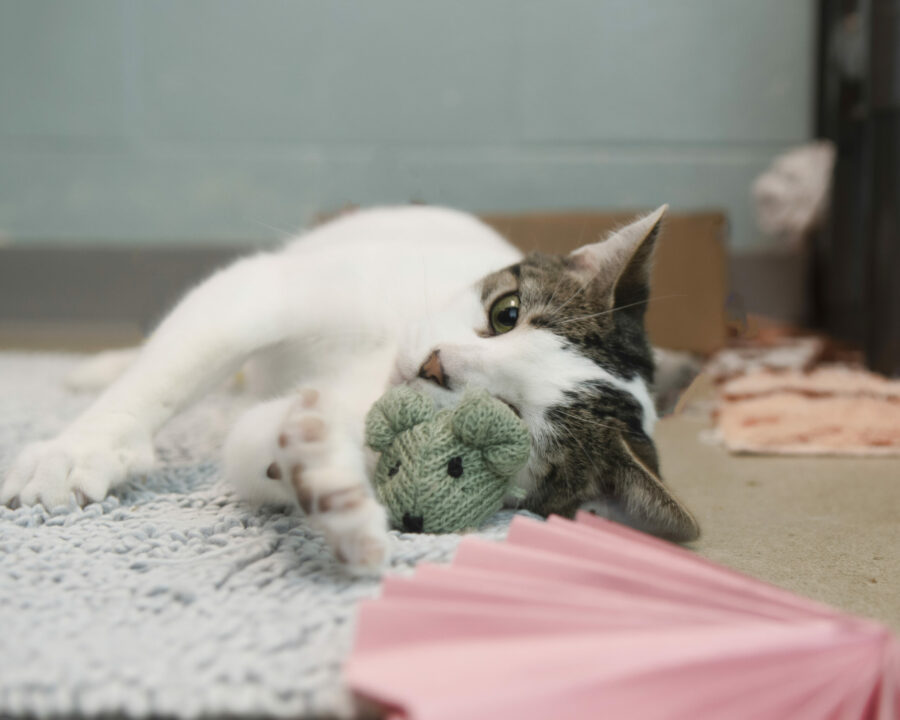
Lindsay Pollard, FFCP (Veterinary), the hospital’s practice manager, says they began trying out some Fear Free methods after hearing about the concept. “A few of our staff members obtained individual certifications,” Pollard says. “After learning more and attending a few conferences where Fear Free was highlighted, we decided to go all the way.” Hanover Veterinary Hospital completed the program to become Fear Free certified in December 2018.
When deciding to become a Fear Free Practice, the biggest difference has been in the way he interacts with the animals after certification, says owner Jeremiah Bieszczak, DVM. “The biggest change has been reading body language and emotional state/stress level and addressing that instead of pushing through it. We are better able to read pets and have more tools and knowledge to deal with these situations.”
Many long-term clients are delighted with the constructive visits they’ve had with Fear Free, and new clients are thrilled with the difference between them and their previous veterinarian, says Pollard. Oftentimes they mention the care and compassion used when handling their pets. Pollard feels they’ve made much progress with many of the patients since becoming Fear Free certified.
Fear Free helps all pets, but scared pets often need Fear Free much more to turn their lives around. Pollard has one patient in particular whom she’ll always remember and says Fear Free methods changed everything for this dog.
The pet was a 14-year-old female shepherd mix. Sally, who has since passed away, desperately needed help. “Prior to our Fear Free certification, both Sally and her owner, Sara Zilz, dreaded coming to the vet. She also had some fear aggression and anxiety issues at home. She had a very high FAS and was fearful to the point of aggression,” says Pollard. “Our exams with her were very limited at best and it took several staff members to accomplish anything with her at all.”
Sally had been adopted by Zilz from the humane society when she was 9 weeks old. She didn’t notice any problems with Sally until she took her for training and Sally became spooked by large signs in the store hanging over her head. Then she began showing other fearful behaviors. Zilz says Sally disliked smoke from the grill and even hated when someone blew out a candle. She started having food-guarding issues and was even afraid of shadows on walks.
Zilz says she never thought about potential problems at the veterinarian’s office. “I had her boarded at Hanover. Dr. Bieszczak came out when I picked her up and nicely said something along the lines of ‘She needs to be medicated before we will take her for another boarding.’ This broke my heart. I did not realize she was that bad.”
A veterinary technician named Bobbi became Sally’s best friend when she was boarded. Bobbi would sit in her kennel with her and try to get her to come out. She wouldn’t even go outside to potty. Bobbi called Zilz several times and asked if she could do some things to help her. After that, Bobbi became Sally’s veterinary technician of choice.
After they became Fear Free certified, Bieszczak started Sally on fluoxetine, an anti-depressant. This medication was a game-changer for her. Pollard says they also started doing happy visits with Sally, using treats with her during exams and treatment, and including calming pheromone products during her happy visits and exams/treatment. They also tried to keep the same staff member working with her all the time, and kept detailed notes on her likes and triggers, constantly adapting their plan and approach to better suit Sally individually.
“She made more progress with each happy visit and regular visit until eventually she was happy to see several staff members,” Pollard says, “and she was happy coming into the building. Sally would readily accept most treatment from us with the help of some treat distractors and enforcers.”
“At one point, I felt everyone wanted to give up on Sally. Once I saw the Hanover Veterinary Hospital staff was not giving up on her, I knew things would be okay,” says Zilz.
This article was reviewed/edited by board-certified veterinary behaviorist Dr. Kenneth Martin and/or veterinary technician specialist in behavior Debbie Martin, LVT.

 Whenever she’s in the veterinary suite, she remembers her Fear Free training. “They are already in pain and probably very stressed,” Killen says, “but by keeping calm, quiet, and moving slowly and predictably, I can help prevent that stress level from rising, which could make them feel even worse.”
Whenever she’s in the veterinary suite, she remembers her Fear Free training. “They are already in pain and probably very stressed,” Killen says, “but by keeping calm, quiet, and moving slowly and predictably, I can help prevent that stress level from rising, which could make them feel even worse.”